Don't wanna be here? Send us removal request.
Text
Simplilearn Data Science Course: A Comprehensive Review
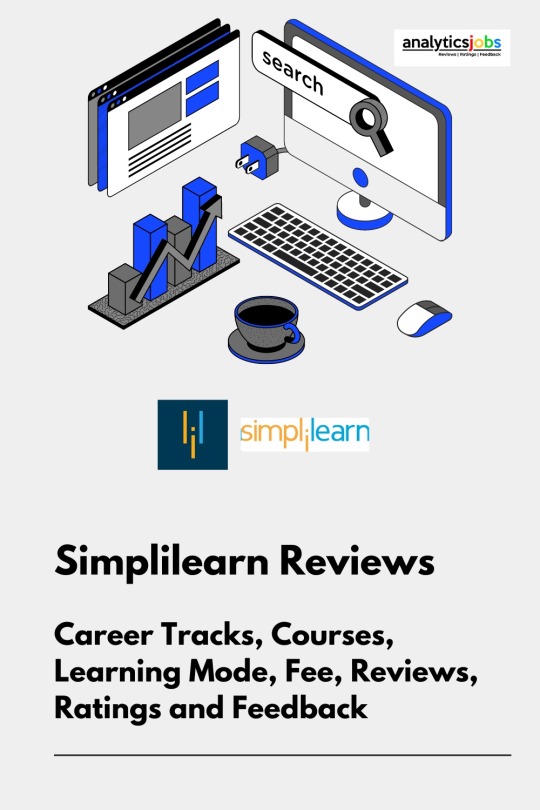
Aspiring professionals seeking to enroll in Simplilearn's data science course are often confronted with a multitude of choices and considerations. In this comprehensive review, we aim to provide honest insights into Simplilearn's data science program, aiding prospective learners in making informed decisions.
Simplilearn, an online learning platform, offers a diverse array of professional certification courses encompassing fields such as digital marketing, project management, cloud computing, cybersecurity, and notably, data science. Our primary objective is to collate genuine reviews from past and present learners who have undergone Simplilearn's data science course, thereby facilitating a transparent assessment for potential learners.
Introduction to Simplilearn: Simplilearn has swiftly emerged as a prominent e-learning platform, boasting collaborative courses from esteemed institutions like IIT Kanpur. Whether you're a novice or an experienced professional, Simplilearn endeavors to cater to your upskilling needs. From its inception in 2009 by Indian engineer Krishna Kumar, Simplilearn has evolved into a global entity with offices in Raleigh, North Carolina, and Bangalore, India.
Course Offerings and Curriculum: Simplilearn's data science curriculum encompasses a wide spectrum of topics, ranging from essential Python programming to advanced machine learning algorithms. Courses are meticulously designed to align with industry trends, ensuring relevance and applicability. Notable offerings include:
Data Science with Python
Data Science with R
Data Science Bootcamp
Post-Graduate Program in Data Science
Data Science Certification Training
Advanced Certification in Data Science and Machine Learning
Unique Features of Simplilearn: Simplilearn distinguishes itself through several key features:
Comprehensive Course Catalog: Simplilearn offers a vast array of courses across various domains, providing learners with ample choices.
Industry-Relevant Curriculum: Courses are crafted to reflect current industry demands, ensuring practical relevance.
Flexible Learning Opportunities: Learners can opt for mentorship-led virtual classrooms or self-paced learning, offering flexibility in learning.
Hands-On Projects and Lab: Practical experience is emphasized through case studies, projects, and lab exercises, enhancing skill acquisition.
Experienced Instructors: Courses are delivered by seasoned instructors with extensive industry knowledge, ensuring high-quality instruction.
Career Assistance: Simplilearn provides career support services, including resume building and interview preparation, enhancing employability.
Global Reach and Community Assistance: Simplilearn's global recognition facilitates networking opportunities through online communities and discussion forums.
24/7 Support: Active platform support ensures timely resolution of technical and course-related queries.
Fee Structure and Enrollment Process: The fee for Simplilearn's Data Science Job Guarantee certification program is ₹198,004 (inclusive of GST), with installment payment options available for convenience. Eligibility criteria include a bachelor's degree with a minimum of 50% marks, basic programming understanding, and 2+ years of work experience.
Pros and Cons: Pros:
In-depth course offerings.
24/7 support and community assistance.
Diverse courses with mentorship.
Job guidance and guarantees for select courses.
Cons:
Lengthy course categorization.
Selective smart chat feature.
Non-pocket-friendly fees.
Limited availability of job guarantee across courses.
Reviews from Various Platforms: Reviews from CourseReport and Trustpilot highlight both positive and negative experiences, emphasizing Simplilearn's strengths and areas for improvement. While some learners commend Simplilearn's offerings and support, others express dissatisfaction with certain aspects of the learning experience.
Conclusion: In conclusion, Simplilearn emerges as a robust platform offering comprehensive data science courses with a focus on practical relevance and industry alignment. Despite some drawbacks, Simplilearn's commitment to providing quality education and career support makes it a viable option for professionals seeking certification and career advancement in the field of data science.
If you want to learn more about this, click here - AnalyticsJobs
#analyticsjobs#simplilearn#simplilearn reviews#simplilearn data science reviews#simplilearn data science courses reviews
0 notes
Text
Understanding Inheritance in Java: Exploring Types and Examples

In the world of Java programming, inheritance is a powerful concept that allows developers to create a relationship between classes, fostering code reuse and organization. In this blog, we'll delve into what inheritance is in Java, explore its types, and provide practical examples to make it all crystal clear.
What is Inheritance in Java?
Inheritance is a key pillar of Object-Oriented Programming (OOP), enabling a class to inherit properties and behaviors from another class. The class granting the inheritance is known as the superclass or parent class, and the class receiving the inheritance is the subclass or child class. This mechanism promotes the reuse of code and establishes a hierarchy among classes.
Types of Inheritance in Java:
1. Single Inheritance:
In single inheritance, a subclass inherits from only one superclass. Let's illustrate this with a simple example:
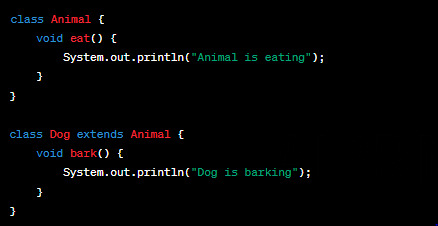
Here, Dog is the subclass inheriting from the Animal superclass. The Dog class can access the eat() method from the Animal class.
2. Multiple Inheritance (Through Interfaces):
Java doesn't support multiple inheritance for classes, but it does support it through interfaces. Consider the following:
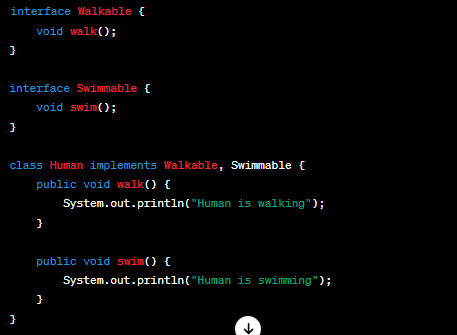
Here, the Human class implements both the Walkable and Swimmable interfaces, achieving a form of multiple inheritance.
3. Multilevel Inheritance:
In multilevel inheritance, a class inherits from another class, and then another class inherits from the second class, forming a chain. Let's see an example:
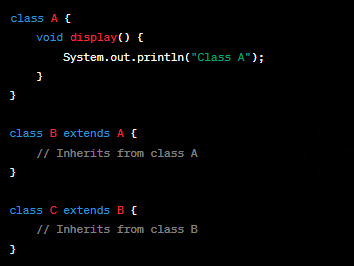
In this scenario, C inherits from B, and B inherits from A.
4. Hierarchical Inheritance:
In hierarchical inheritance, multiple classes inherit from a single superclass, creating a hierarchy. Consider the following:
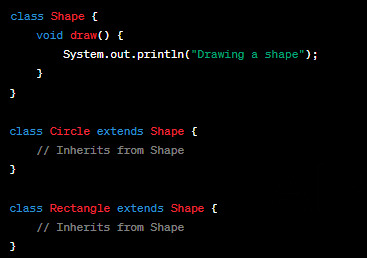
Here, both Circle and Rectangle inherit from the Shape superclass.
Benefits of Inheritance:
Code Reusability: Inheritance allows you to reuse code from existing classes, minimizing redundancy.
Method Overriding: Subclasses can provide specific implementations for methods inherited from the superclass.
Polymorphism: Objects of the subclass can be treated as objects of the superclass, enhancing flexibility.
Modularity: Inheritance aids in creating modular and easily understandable code by organizing classes into a hierarchical structure.
Conclusion
In conclusion, understanding inheritance in Java is fundamental to writing efficient and organized code. Whether you're a beginner or an experienced developer, incorporating inheritance into your Java programming skills can significantly enhance your ability to create robust and maintainable applications.
Get to Know more: https://analyticsjobs.in/question/can-you-please-tell-me-what-are-the-various-types-of-inheritance-in-java/
#java#inheritance in java#learn java#analyticsjobs#what is inheritance#types of inheritance#elearning#coding#programming
0 notes
Text

Navigating Efficiency: A Comprehensive Guide to the Binary Search Algorithm
In the vast landscape of algorithms, one star shines bright in the realm of search operations—Binary Search. This comprehensive guide aims to demystify the intricacies of this algorithm, exploring not only its mechanics but also delving into the crucial aspect of time complexity. Join us on a journey to unlock the power of efficiency.
Understanding Binary Search:
Binary Search Demystified:
Imagine you have a library of books neatly arranged in alphabetical order. Binary search is like finding a specific book by repeatedly splitting the remaining possibilities in half. You start in the middle, decide if the target is in the left or right half, and continue this process until you've pinpointed the book. This systematic approach is the heartbeat of binary search.
Real-World Scenario:
Consider a scenario where you're searching for a friend in a phone book. You open it in the middle, decide whether their name would be in the first or second half, and repeat until you locate the right entry. This mirrors the efficiency of binary search in swiftly finding elements in a sorted collection.
Time Complexity Unveiled:
The Essence of Time Complexity:
Now, let's dive into the critical realm of time complexity. Binary search boasts a time complexity of O(log n), where n is the number of elements. To put it simply, as your dataset grows, binary search's efficiency doesn't increase at the same pace as linear search, making it a go-to solution for large datasets.
Visualizing Time Complexity:
Picture a scenario where you're searching for a specific contact in your phone—a linear search would involve scrolling through each entry, while binary search mirrors the efficiency of quickly narrowing down your contacts by jumping to the middle, then deciding which half to explore.
Real-Life Applications:
Binary Search in Everyday Scenarios:
Consider managing an extensive contact list on your phone, sorted by names. Binary search becomes your ally in swiftly locating a friend's contact information without scrolling through every entry. This efficiency becomes even more pronounced in scenarios like online databases or searching for elements in a sorted array.
Optimizing Database Queries:
In the realm of databases, where time is of the essence, binary search becomes a game-changer. Whether you're searching for a specific record by ID or querying a sorted dataset for relevant information, the algorithm's efficiency enhances response times and user experience.
Conclusion:
As we conclude our exploration of the Binary Search Algorithm, it stands as a beacon of efficiency in the sea of algorithms. Its simplicity, coupled with the elegance of divide and conquer, makes it a valuable asset in the toolbox of any programmer or data scientist.
Armed with the knowledge of binary search and its time complexity advantages, you're empowered to optimize search operations and enhance the responsiveness of your applications. In the dynamic world of technology, where speed and efficiency are paramount, understanding the nuances of binary search opens doors to a realm of possibilities, making your journey through the vast data landscape smoother and more rewarding.
Know more: Click Here
0 notes
Text
Understanding SGPA and CGPA: A Comprehensive Guide to Academic Grading

Introduction
Within the academic sphere, terms such as SGPA and CGPA frequently circulate, prompting students to ponder their significance and the methods used for their calculation. Both SGPA and CGPA stand as crucial benchmarks in evaluating academic performance, playing a central role in comprehending a student's accomplishments throughout their academic odyssey. This blog post aims to unravel the definitions of SGPA and CGPA, elucidate the steps involved in their calculation, and delve into the process of converting SGPA into a percentage.
Understanding SGPA
SGPA, or Semester Grade Point Average, serves as a metric to assess a student's performance in a specific academic term. It furnishes a numeric representation of grades achieved in individual courses during that term, typically measured on a scale of 0 to 10, where 10 denotes the highest achievable grade. Each course is assigned specific credit hours, and the SGPA is determined based on the grades obtained in those courses.
How to Calculate SGPA?
The computation of SGPA employs a straightforward formula that factors in the grade points earned in each course and their corresponding credit hours. The process can be delineated as follows:
Assign grade points: Attribute specific grade points to each letter grade (A, B, C, etc.), such as assigning 10 points to an A, 8 points to a B, and so forth.
Multiply grade points by credit hours: Multiply the grade points earned in each course by the credit hours allocated to that course.
Calculate total grade points: Sum up all the grade points obtained across all courses.
Calculate SGPA: Divide the total grade points by the total credit hours.
The resulting value signifies the SGPA for that specific semester.
Understanding CGPA
CGPA, or Cumulative Grade Point Average, serves as an average of the SGPA values accumulated across multiple semesters, offering a comprehensive overview of a student's academic performance throughout their entire academic journey. Like SGPA, CGPA is measured on a scale of 0 to 10.
How to Calculate CGPA?
The calculation of CGPA entails consolidating SGPA values from each semester and calculating their average. The process unfolds as follows:
Calculate SGPA for each semester using the aforementioned steps.
Sum up the SGPA values for all semesters.
Divide the total SGPA by the number of semesters.
The outcome represents the CGPA, providing a holistic assessment of a student's academic achievements over various semesters.
Converting SGPA into Percentage
While SGPA offers a detailed view of a student's performance, certain educational institutions and employers often seek percentage scores for standardized comparisons. Converting SGPA into a percentage involves a straightforward formula:
Percentage=(SGPA10)×100Percentage=(10SGPA)×100
This formula scales the SGPA value to a percentage by dividing it by the maximum possible SGPA (10) and multiplying the result by 100.
Conclusion
In conclusion, a profound understanding of SGPA and CGPA is imperative for students to accurately gauge their academic progress. SGPA mirrors performance in a specific semester, while CGPA provides a cumulative perspective. Proficiency in calculating SGPA and CGPA empowers students to monitor their progress effectively. Furthermore, converting SGPA into a percentage streamlines communication with institutions and employers using percentage-based evaluation systems. Armed with this knowledge, students can traverse the academic landscape with clarity, making informed decisions about their educational and professional paths.
To know more, Click Here: https://analyticsjobs.in/question/how-to-calculate-sgpa-and-cgpa/
0 notes
Text
Top Highest Paying Jobs in India 2024 - Choose Wisely!

Introduction
In the ever-changing landscape of the Indian job market, individuals are maneuvering through a mix of opportunities and challenges, aiming to secure positions that not only resonate with their passions but also provide substantial financial rewards. Let's delve into the panorama of the highest paying jobs in India, gaining insights into the factors shaping this dynamic landscape.
The Current Job Market
The job market in India is undergoing a transformative shift, influenced by technological advancements and global economic trends. As the country positions itself as a hub for innovation, specific sectors are experiencing unprecedented growth, redefining the landscape of lucrative employment.
Emerging Industries
In addition to traditional sectors, emerging industries play a pivotal role in job creation and financial prosperity. From artificial intelligence to renewable energy, professionals in these fields command high salaries, contributing significantly to the economic fabric.
Top-Paying Professions
Technology Dominance
In the era of digital transformation, roles related to technology have become synonymous with high-paying jobs. Data scientists, cybersecurity experts, and software engineers are in constant demand, reflecting the digitalization wave sweeping across industries.
Healthcare Boom
The healthcare sector is also witnessing a surge in demand for skilled professionals. Surgeons, healthcare administrators, and specialized nurses are among the top earners, fueled by the growing emphasis on health and well-being.
Financial Sector Trends
Financial analysts, investment bankers, and wealth managers are benefiting from a robust financial sector. As India's economy continues to evolve, professionals with financial acumen secure top-tier positions.
Skills in Demand
In this competitive job market, possessing the right skills is imperative. Employers seek individuals proficient in data analysis, artificial intelligence, and interpersonal skills. Adapting to the evolving needs of industries ensures a competitive edge in securing high-paying roles.
Educational Pathways
Navigating educational pathways is crucial for aspiring professionals. Pursuing degrees in technology, healthcare, and finance opens doors to lucrative opportunities, providing a foundation for a successful career trajectory.
Remote Work Revolution
The advent of remote work has disrupted traditional employment norms. Professionals across various domains are now exploring remote opportunities, enabling them to balance work and personal life while still enjoying lucrative salaries.
Gender Pay Gap
While strides have been made towards gender equality, a notable pay gap persists. Understanding and addressing this gap is crucial for fostering a truly inclusive job market, where everyone is compensated fairly for their skills and contributions.
Government Initiatives
Government initiatives play a vital role in shaping the job market. Policies promoting skill development, entrepreneurship, and inclusive hiring practices contribute to creating an environment conducive to high-paying jobs.
Balancing Passion & Pay
Finding the right balance between passion and pay is a common conundrum. While financial rewards are essential, individuals are increasingly seeking professions that align with their interests, creating a harmonious blend of job satisfaction and financial stability.
Conclusion
The landscape of the highest paying jobs in India is multifaceted, offering a myriad of opportunities for those navigating the job market. From technological dominance to healthcare revolutions, the key lies in aligning skills with emerging trends while ensuring a balance between passion and financial gain.
#highestpayingjobs#jobs#howtoearnmore#analyticsjobs#bestcareer#careers#choosingcareers#careerreviews
0 notes
Text
Best Computer Courses to Pursue in 2024 - A Beginner's Guide

In the rapidly evolving realm of technology, the demand for individuals proficient in computer skills has reached unprecedented levels. Whether you're a recent graduate, changing careers, or seeking to enhance your skills, the right computer course can unlock numerous opportunities. This article explores the best computer courses for beginners in 2024.
I. Introduction
In today's digital age, a robust understanding of computer science is not just beneficial; it's almost indispensable. With technology's continual advancement, the demand for professionals skilled in best computer courses is escalating. This guide is designed to assist beginners in navigating the myriad of options and selecting the most suitable computer course for their journey.
II. Top Computer Courses for Beginners
A. Web Development
Front-end Development
Involves creating the visual elements of a website, focusing on HTML, CSS, and JavaScript.
Back-end Development
Crucial for those interested in the server-side of websites, involving databases, servers, and application logic.
B. Data Science and Analytics
Introduction to Data Science
Focuses on extracting meaningful insights from data, covering basics of data analysis, statistics, and machine learning.
Analyzing Big Data Sets
Emphasizes understanding and deriving insights from large datasets, a crucial skill in the era of big data.
C. Cybersecurity
Importance of Cybersecurity
Addresses the growing cyber threats, teaching beginners how to protect systems and networks.
Types of Cybersecurity Courses
Offers various courses from ethical hacking to network security, catering to different interests and skill levels.
D. Digital Marketing
Basics of Digital Marketing
Covers fundamental aspects of online marketing, including SEO, social media marketing, and content marketing.
Social Media Marketing
Focuses on leveraging social media platforms for effective marketing.
E. Programming Languages
Python Programming
Known for its simplicity and versatility, ideal for beginners covering basic syntax to advanced applications.
Java Programming
Remains a popular language, providing a solid foundation for software development.
III. Benefits of Pursuing Computer Courses
A. Career Opportunities
High Demand for Skilled Professionals
Industries actively seek individuals with expertise in various computer courses, resulting in a high demand for skilled professionals.
Diverse Job Opportunities
Skills acquired through computer courses open doors to diverse job opportunities, from software development to data analysis.
B. Skill Enhancement
Acquiring In-Demand Skills
Computer courses focus on current industry needs, ensuring learners acquire skills in high demand.
Staying Relevant in the Job Market
Continuous learning through computer courses helps individuals stay relevant and competitive in the ever-evolving job market.
IV. Choosing the Right Course
A. Self-Assessment
Identifying Personal Interests
Before selecting a course, beginners should identify their interests and align them with available courses.
Assessing Career Goals
Understanding long-term career goals is essential in choosing a course aligning with professional aspirations.
B. Research and Reviews
Exploring Course Reviews
Reading reviews from past learners provides valuable insights into the quality and effectiveness of a course.
Seeking Advice from Professionals
Connecting with professionals in the field for advice guides beginners in making informed decisions.
V. Overcoming Challenges as a Beginner
A. Overcoming Impostor Syndrome
Acknowledging and understanding that impostor syndrome is common among beginners.
B. Managing Time Effectively
Balancing work, personal life, and learning can be challenging; creating a schedule and prioritizing tasks helps manage time effectively.
C. Building a Support System
Having a support system, whether friends, family, or fellow learners, provides encouragement during challenging times.
Conclusion
In conclusion, choosing the best computer course in 2024 as a beginner is a crucial step toward a rewarding and dynamic career. By identifying personal interests, setting career goals, and leveraging online learning platforms, individuals can embark on a journey of skill enhancement and professional growth. Remember, the world of technology is ever-evolving, and staying updated is key to long-term success.
#it course#data analysis#big data#technology#datascience#computer courses#computer courses in hyderabad#analyticsjobs
0 notes
Text
Simplilearn Reviews
Introduction:
In the ever-evolving landscape of online education, Simplilearn has emerged as a prominent player, offering a variety of courses to individuals seeking to upskill or pivot their careers. With the plethora of online learning platforms available, it's essential to separate the hype from reality. In this blog post, we'll delve into Simplilearn reviews to uncover the real truth behind its reputation.
Course Content and Quality:
Simplilearn offers a wide array of courses spanning various domains such as data science, digital marketing, project management, and more. Reviews often highlight the relevance and depth of the course content. Many learners appreciate the real-world applicability of the skills acquired through Simplilearn courses, with hands-on projects and case studies being a standout feature. The inclusion of industry-relevant certifications adds further credibility to the courses.
Expert Instructors:
The quality of instructors can make or break an online learning experience. Simplilearn boasts a roster of experienced industry professionals as instructors. Learners commend the expertise and practical insights that instructors bring to the courses. The inclusion of live sessions and Q&A sessions allows students to interact directly with experts, enhancing the overall learning experience.
Flexibility and Accessibility:
Flexibility is a key advantage of online learning, and Simplilearn understands the importance of accommodating diverse learner needs. Reviews frequently highlight the flexibility in scheduling, enabling individuals with busy lifestyles to pursue their educational goals. Additionally, the accessibility of course materials even after course completion ensures that learners can revisit and reinforce their knowledge whenever necessary.
Community and Support:
Simplilearn fosters a sense of community among its learners through forums and discussion boards. Reviews often emphasize the supportiveness of the community, with students exchanging insights, tips, and advice. The availability of customer support is another positive aspect, ensuring that learners can seek assistance promptly if faced with any issues during their learning journey.
Conclusion:
While no learning platform is without its flaws, Simplilearn has managed to establish a positive reputation based on its commitment to providing quality education with a focus on practical skills. The real truth behind Simplilearn reviews lies in the consistently positive feedback regarding user experience, course content, expert instructors, flexibility, and community support. As with any educational investment, it's crucial for individuals to assess their specific needs and goals before embarking on their learning journey with Simplilearn.
To Know more about Simplilearn, Click Here: Simplilearn Review
1 note
·
View note